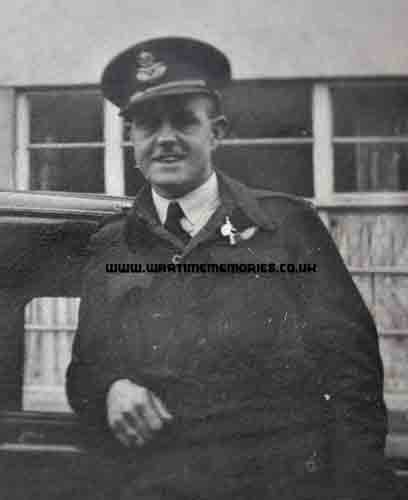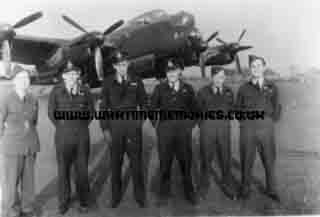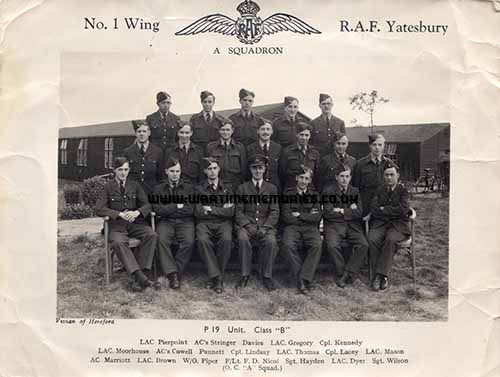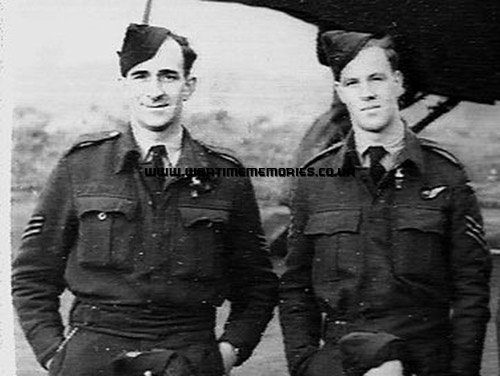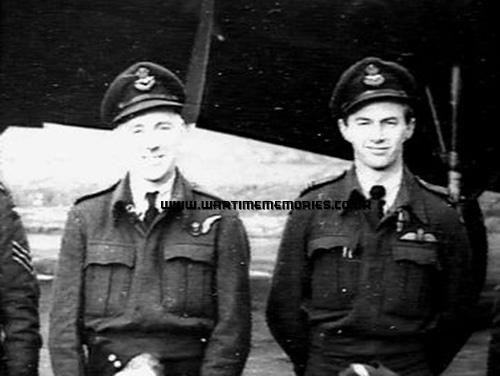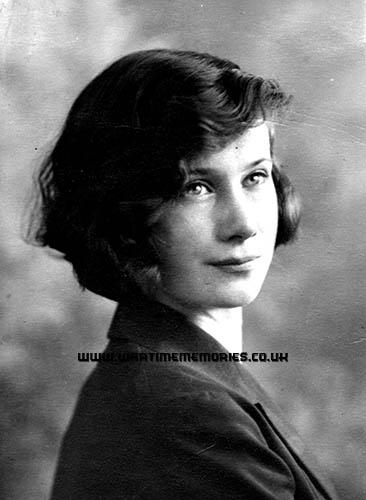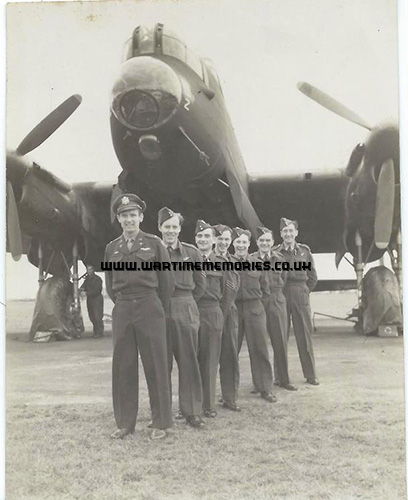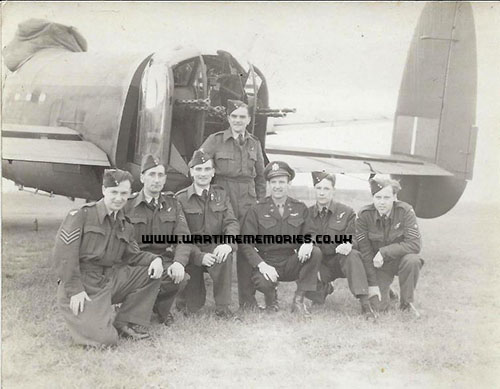F/Sgt. William Arthur Wooldridge B Flight 90 Squadron
In memory of the Mother I never knew And the Father I nearly lost.
This picture that now suddenly appeared on the mantle-piece was of a RAF Bomber, its flight and ground crew. Over the coming months I got to know who they were, In dad's flying log book his release date was 5th of June 1946, he ended his wartime service career at RAF St Faiths now Norwich International Airport, so the photograph on the mantlepiece dates from June 1946.
At this time I was eight and a half years old now schooling at George White Junior School. Dad told me the names of all the aircrew but not the ground crew. I could recognise most of them but for some reason the name Jimmy Ginn sounded oriental so I assumed that the guy on the back row extreme right was Jimmy. But, it was not until the summer of 2006 sixty years later did I finally get them in the right order. My apologies to the bomb aimer Ross Meggason (Third left) and the radio operator Jimmy Ginn.
As a schoolboy I fantasised of meeting them but Canada was a world away and the computer and the world wide web had not been invented, neither had television, plastic, credit cards and the biro. During the 1970's I bought dad a portable tape recorder and asked him to record his wartime memories.
Dad passed away in September 1979 (my mother had passed away in September 1939) and several weeks later my Aunt Alice gave me an audio tape with "Operations XC Sqd - W A Wooldridge" marked on it. If it was not for this tape the events that eventually transpired would never have happened, and for this dad I thank you so much.... this is my father's story.
My Life in the RAF during WW2.
By Flight Sergeant William Arthur Wooldridge No. 1876129,
Flight Engineer, Lancaster I, RAF 90 Squadron, Tuddenham,
Suffolk.
A transcription of audiotapes pre-recorded around 1978 over 30 years after the event sitting by the fire with his flying log book in hand. Dad was not a well man after two strokes and a fading memory and to do as well as he did was remarkable, the umm's and rr's have been ignored and the Norfolk brogue translated into the Queen's English.
The Search for Kaiser's Crew
Bill Wooldridge, Pete Campbell, Ross Meggason. Jack Kaiser, Jimmy Ginn. Clare Telford and Howard Keon
It Turned Out All Right
This is a brief summary of my life in the RAF during the war as a Flight Engineer, I'm Flight Sergeant Wooldridge, or was, number 1876129, I entered as a trainee in October 1944, I went to London on a co-op, I received my kit and "what not" and we were there for about a week with injections and such like and we were shipped to Whitley Bay in Northumberland. There we spent six weeks of fairly hard slog doing basic training, it was a very cold winter and you needed plenty of exercise to keep warm.
After about six weeks of that we went down to St Athens in Cornwall, no sorry, not in Cornwall but in South Wales, there was nothing outstanding about that apart from a hard slog, mainly mental work, I was not used to mental work but somehow I got through it, very little happened to us in that way only such a guard duties and things like that which didn't mount up to much.
After six months of that I passed out at 63.2% which is about average there was very few of them got much more than that, and the one of our flight got who got about 70% he received some sort of prize as the best student for that year, he was an Irishman in fact, Southern Irish.
We went from there to Con Unit (Conversion Unit) at first to pick up our crew, or rather the pilot picked up his crew, because he had been on Wimpey's, a twin engined aircraft doing his training, he picked up his crew somewhere else then when they got to number 1653 Con Unit at Chedburgh which was in Suffolk. They picked up the engineer, we met our skipper Fl/O Kaiser, the Navigator was Howard Keon, the Bomb Aimer was Ross Meggason, these three were all Canadians, and also our Rear Gunner Clare Telford, he was another Canadian, and myself Sergeant Wooldridge and Jimmy Ginn who was the Wireless Operator and Pete Campbell who was the Mid Upper and that was our crew.
We spent about six week at Con Unit and we did all of this on Stirling's which was a four engined job, good kite but it had an all electric switch over for the petrol tanks and I think from memory about 27 petrol tanks on this and it took a little bit of understanding, one or two things happened like the air came out of a tyre just as we were landing but we were all right, it didn't do us any harm. After August the 14th to the 29th we were on Stirlings training for circuits and landings and cross country bombing, high level bombing and camera shots for gunnery, We passed out from there and went on to No 3 Lanc finishing school at Feltwell, well that was the first time we came up against a Lancaster, apart than from books we had never been in one, never actually been close to one. There we picked up our Lanc. and from there we did circuits and landings and local flying and flashlight cross country flights for gunnery and suchlike.
After about 3 or 4 days there we were allocated a squadron, we went to 90 squadron at Tuddenham which was between Bury St Edmonds and Barton Mills in Suffolk. We had been there about a week then they decided to make two squadrons so they made one 90 Squadron and the other 89 Squadron, we remained at Tuddenham and 89 went off to a small station just a few miles away from us. We did a certain amount of training flights there and fighter affiliation with fighters going up and taking camera shots at you and the gunners did their stuff on them. One thing happened there was we went on a cross country flight one day and we were supposed to drop bombs on a gunnery range in the Midlands and it was my job to drop any unwanted bombs and such like, when we were coming over we bombed and as we were coming passed they said there was one still hanging up so they said "get back Bill and release it" I Short Stirling J/WP flown by Kaisers crew on Aug 25th 1944 on a Bullseye cross country flight opened the bomb compartment pulled the lever and the whole ruddy rack went as well, we got told off when we came down as we nearly crowned someone as well when they hit the floor, That was one of the few mistakes I made, luckily it turned out alright.
Then came our first flight to a place called Westkapelle on the Dutch coast somewhere very short only 2 hours and 15 minutes, we had a bit of flak, the first flak we had seen but they didn't bother us too much, from there we had Duisburg two nights then Stuttgart Essen & Cologne, nothing unusual happened there, plenty of flak but as long as it did not hit us we were not bothered. Then in October we went to a place called Wessling and that's where we met a little opposition. That was in WP/Y Yorkie and we got shot full of holes, the amazing thing about it was that nobody got hit, the aircraft was just a pepper pot, the only other thing was that we had a hole in the starboard wing you could nearly put your head through, we lost a lot of aviation fuel but we could not have lost very much as we got home alright.
After we had done a few more bombing trips we spent 3 or 4 days on Gee H training on what they called a Gee box, you homed on your target on this Gee then turn and home on Gee as well, I didn't understand much about it not being the Navigator or wireless opp, I could not interest myself in anything like that, I didn't know much about it only what we were actually doing but how it worked I didn't know, it was purely electrical.
There was a kind of hum drum effect of flying then, you had a job to do, you did it and that's where it finished well up to a point, up to the first ten you did not really know what it was all about, on the second ten it just about began to sink in what that meant and on the third ten you were sweating like hell whether you would get through it, but howsoever I was lucky as it turned out alright.
We then went to a place called Schwammanauel Dam somewhere either in France or Germany, I had never heard of it before, our troops we supposed to be reaching up to this dam, and we were supposed to bomb the dam only if we could see it, when we got over there and turned on the target the master bomber decided there was nothing to be done about it so we turned round and come back again but Jack our skipper got permission from the master bomber to go down and see what it was all about. Well we got down below the clouds, we could not see a lot so we came up again, we were bombing between 15 & 17000 feet then so you couldn't see too much about it in any case. So, that was the Schwammanauel Dam, we came back and dropped our bombs not in the sea but on some other target we found on the way home.
Our longest trip of the lot was Murzeburgh 1990 Petrol it was a long trip 7 hours 15 min it was getting fairly boring at the finish, mainly fire bombs , over there the place was absolutely on blaze, we dropped our lot and hopped off home ,it was at night time we had seen enough of that, The next one we went to Duisberg, we had already done that one once, and the next day we took an aircraft to Chedburgh, which had been repaired and came back by road, nice little half hours trip,From there we did one to Witton somewhere in Germany and that is where our port outer packed up and developed a fault we were in charge of the flight that time, they were following us, we got halfway there and suddenly our port outer engine packed up something about the oil system somewhere, you could see it on the gauge but I could not puzzle out quite what is was , anyway we bombed on 3 , as we were going out , soon as they saw our engine stop the others veered off but we kept going and turned round and come back, we were fortunate coming home because as you got in the corridor round the airfield you had to wait sometimes half an hour before you could get down, you had to take your place in the queue but with one engine US they let us get down fairly quickly so that wasn't too bad, When we got down they found that the oil regulator on the engine was gone and was only letting a light measure of oil through, instead of going up to 8 or 10 pounds it was allowing only about 2 or 3 , it would have eventually ruined the engine if we hadn't stopped it, but that finished up alright.
Then from there we went to Coblenz, I did not know where these German targets were and from there we had a mining attack, each crew at some period during their ops had to do one of these trips, they were low level, we would travel out over the sea. Before each ops we had to be careful what we ate,especially if it would give us wind, beans or peas or anything like that, naturally we refrained, but all of a sudden they called the mining attack off, so the next thing we had our meal in the normal way,
sausage, chips, beans etc, a dam good meal, then suddenly they came and said Kaisers crew were wanted so we went on this mining attack we went out somewhere about 1000feet, we were very low over the sea, we could see the waves underneath, when we got over the target we went up to 12000feet and dropped
our mines, they were huge, damm great things in big canisters, On the way back we were attacked by a Junkers 88, our crew were watching it, they didn't actually fire on it, but we were so low he could not do anything about it, Half way home I rang up Pete Campbell on the intercom and asked if he had any trouble he said no he was alright, I said I have got the bellyache and got it bad, it was the ruddy beans I ate and it is playing me hell, I could not get rid of the wind at all, I tried too but I couldn't but we got back alright, after walking about it got better, but it was pretty rough while it was there.
From there we went to Vohwinkel then to Nurnberg, this was the second longest trip we had, it was a night trip as well, we then went to a place called Siegen then we got recalled, that is where coming back over the North Sea we had to get rid of all of our bombs, we were told not to bring anything back and there was a special place in the sea were we used to go release these bombs, when they went off it was like someone giving you a kick up the backside you could feel it from well over 5000feet when we dropped, it may have been higher than that, I cant remember, anyway we got rid of them and dropped down.
The next one of any note was Ludwigshaven in daylight that was a 5-50 trip, and that was where we really knew what it was all about, I got a peculiar impression there as I looked out of the window in front of us out of the nose there was a mass of black spots all over the sky, this flak, I felt exactly if I could get out and walk on it at 19000feet, a peculiar sensation and I have never forgotten it, and there were a lot of fighters about that day, coming in all over the place, we saw some of ours go down, some got direct hits, some of them were making hell of our lot we had orders to keep straight and not to do any weaving but we did a bit of weaving and got told off when we got down but we were not going to stick that ruddy lot, they were around us like flies, howsoever we bombed and turned round and came
back again ruddy glad it was all over it was just about the nastiest one of the lot.
Then we went to Neuss then on to Saarbrucken, as we were coming back our station was supposed to be in fog so the diverted us to Predannack in Cornwall we had done 6 hours 20 then, I have seen this airfield after the war when I went down there on holiday it was like a lot of airfields it has been left you could hardly tell it had been an airfield, we came down there
as one of our starboard engines was acting a bit funny but we got it going again on the Sunday morning and we came back under our own steam and we weren't too bad, a nice pleasant trip, a beautiful morning and we were about two hours to base and that turned out alright.
Then we went to another on Erkensewick I didn't know much about that I think it was P Peter our last trip and on the way back they talked about as to shooting up the drome which had been banned for some time because they were such afraid that being such a big kite they might do some damage so they banned it, but at the finish the skipper decided to have a go at it, I have never flown in a dammed great aircraft like a Lanc and seen what that can do like it did, he dammed near put it in a turn, a spiral and what not, he done everything bar but upside down, we came down over the aerodrome over the canteen and the ground crew said they had never seen anything like it howsoever it turned out alright, but the skipped got called over the coals about it, nearly got a court marshal over it, but it turned out alright.
Skipper went in to see the CO and when he came back he said the CO wanted to know if we wanted to go on pathfinders, we dammed near scragged him we told him if he wanted to go he could go his ruddy self, but the mid upper gunner Pete Campbell, they were all young, I could see he had nearly had it, he was a bundle of nerves, so after some debate they decided to let it go at that, Jack the skipper would have gone, we would not wear it, we had had enough and we wanted a rest , and that is more or less the sum total of my operational life in the RAF during the war, somewhere between 160
operational hours all in all , if you were lucky like we were that wasn't a bad life you never got too much bull or anything like that life was really straight forward but once you got busted up once or twice it wasn't very pleasant, but we were very fortunate, Once Jack got a piece of flak through his canopy down the side of his face and knocked him groggy for a minute and manage to keep control of the aircraft and asked me to stand by, when I told him he was alright he told me to get out of the ruddy way, then I knew he was alright so we let it go at that, then there was another time when Ross the bomb aimer got one down the side of his neck, it was nothing much, we shoved a bandage round it and he was alright, as I say apart from a few minor cases we didn't do too bad, one thing we never did find out there was a hole behind me, that was roughly in line with Howard there was a hole you
could get a penny through it and we never did find what came through it never hit the navigator so we just wrote that off as another bit of good luck.
After that they sent us home on leave for about 6 weeks, I was beginning to wonder whether they wanted me back anymore but all of a sudden we went back to Tuddenham and there they sent us up to Catterick, we spent a few days moping about doing nothing, they sorted us out. We had various tests what we were going to be any use for on the ground, and me I had been a practical man all my life but they decided to give me a clerks job, I went on a equipment course at Kirkham in Lancashire.
We spent another six weeks in Kirkam, we had a good time there, a real laugh, we managed to pass out alright, more by luck than anything else, we were larking about so much it was surprising we ever got through anything up there . Howsoever we got through there and they sent me to Morcambe on the front, we had a big Littlewoods store for equipment and what not , I spent six months there, nothing much to do except clerking in the equipment store. I had two nice WAAF's with me, I was supposed to be under them but there wern't a lot to do, we had a good time.
Just before the end we had VE day up there.
The Search Begins
In 1989 I wrote to the 90 Squadron veterans association, the reply stated that they had a member called Ross Meggason the Canadian bomb aimer, why I did not follow this lead up I cant imagine, this was to cost me dearly in later years as Ross passed away so I never met him. Dad had lost touch with all of them except Ross but I have never found any correspondence, not even a Xmas card.
By 2006 I had become very familiar with the world wide web and had found a website called World War 2 Ex RAF, I placed an advertisement listing all the names and information together with a picture of dad on uniform, and then waited and waited and waited, I checked the website regularly with no results, then I got the following e-mail..
Michael,
I am a retired Royal Canadian Mounted Policeman. I retired in January of this year, at the age of 52. I had given her Majesty 30 years service and decided it was time to do something else. Well I wasn't retired long, as I was recruited into becoming an officer with the reserve and assisting in the training of cadets.
I was delighted to hear from you. I had just asked Lt Col Kaiser to allow me the privilege of interviewing him for historical purposes. He has agreed to spend a few afternoons allowing me to take down the perilous events that so changed the history of the world. Both your father Jack and his crew gave so much to ensure the democratic way of life.
I told Jack about your request and he indicated he would love to hear from you. I provided him with your email address and I anticipate he will contact you in the next few days by email.... Cheers I am extremely happy, that you have made this contact after so many years.
William James Edington Dornan
Officer Cadet, 257 Parallel Squadron
Ladysmith, British Columbia
And followed the first contact with, now Wing Commander Jack Kaiser DFC RCAF (Rtd).
Michael,
You have found me through Bill Dornan. He and a friend, a commercial pilot whom I trained, came to my house a few evening past and lo and behold almost the first thing they asked was "do you know Bill Wooldridge?". I nearly jumped all over them with questions and answers, they gave me your email address, which I hope I have used correctly.
Many times I tried to find Bill through the RAF and newspaper advertisements when Gabrielle (my British wife) and I were visiting the UK. All to no avail. But first to what I imagine are your questions: Where are the others and are they alive. Just our Navigator, Howard Keon, Claire Telford. rear gunner and I remain, Howard Keon, Father Keon, recently retired from the R.C.church and living in Toronto.
After Ops he returned to Canada and worked at A.V.Roe (called AVROE) in Toronto, though I did not know it at the time he installed the avionics in one of the first Canadian CF 100s which I subsequently flew. Howard is alive and well.
Claire Telford, Rear Gunner. Claire is alive and well and lives in Peterborough Ontario. He joined our crew after having completed two trips with another crew. He did not talk a lot and I carefully never asked him why he was available.
Ross Megisson, Went back to the farm in Goodlands Manitoba (about 50 miles west of Winnipeg). I saw him a few times, once he met me in Saskatoon and baby-sat my son Chris. He and your Dad were the steadying force that kept me going (many times). Those two were so different yet both were pillars of strength, which even now I cannot describe.
Jimmy Ginn, Radio Operator, lived in Manchester. I communicated by mail with him for a few years and so did Howard then about 1975 I got a short message from a family member to advise me he had died of natural causes (whatever that means).
Peter Campbell, Mid Upper Gunner. In 1947 I went to his home just outside of London (near Wembley), his family had moved and the people there told me Pete was working with an Oil Company in Africa and they did not know where his family were.
As to myself, after bouncing around between London and Harris, Saskatchewan (farming) when Korea broke out they re-recruited me and I went back to the RCAF where I stayed to June 1975. I retired as a Wing Commander (Canadian military buggered ranks and services all over the place) and so officially called me a Lieutenant Colonel (I prefer Wing Commander).
I must go for now but will email you more data and a few stories about your Dad and the rest of the crew. Bill Dornan gave me your email address I sure hope it works, Sincerely Jack Kaiser.
In the following months many e-mails were exchanged with stories of operational events adding to
Dad's recollections but in more detail, Dad's favourite comment was, but it turned out alright, Jack's stories were more factual and far more dangerous than Dad had led me to believe, when he wrote his account he was 64/65 years old and in failing health also he never exaggerated but
preferred to play the danger down, when I learned the events of the full story my admiration of him as my dad and his fellow crew members reached the highest level, he also got up to some antics that I cant imagine him doing, not the dad I grew up with. Of all the many stories Jack has passed to me the one over the Holland Belgium border in daylight
had the most significance, after losing two of the four engines on Y (Yorker) and alone in the sky and all the rest of the attack force growing further and further ahead, heading for home after attacking Wesseling, an 4hr 10min flight starting at 09:10 in the morning, fighters appeared, the
date was Monday 30th October 1944, I was 6 years & 11 months old, it was at this moment that the events to follow could have made me an orphan as mum had died 6 years before.
The rear gunner Clare reported over the intercom, 4 fighters behind us and closing fast! Dad immediately started the feathered right inner merlin then Clare reported, It's ok skipper the fighters are Yankee Mustangs they escorted the crippled Lancaster for about 20 minutes until they were out of danger, the hair still stands up on the back of my neck every time I read this log report.
After years of searching and with the help of brother in law Cliff Robinson who found a picture of three Avro Lancasters bearing the markings of 90 Squadron, on closer inspection they were E (Echo), U (Uniform) & Y (Yorker)
which has a rare USA style painting on the nose Cherokee. Kaisers crew flew 2 flights in Uniform, one was a circuit training flight an the other
was on 13th of January 1945 on a bombing mission to Saarbrucken, take off was at 11.54pm and lasted for four hours 25 min, on the way back due to bad weather they were diverted to a overnight stop at RAF Predannack in Cornwall, then they had a total of 10 flights in Yorker, all but one ops,
Duisburg, Bombing air test, Stuttgart, Neuss, 2/Essen, Cologne, then the infamous Wessling raid on the 30th of October 1944, Castrop Rauxel and finally Homberg, the last mission was in P (Peter) to Erkenscwick on the 15th of January 1945 giving a grand total of 160 hours 40min air time and total of 30
missions.
Another rare picture found in a book, a lone Lancaster of 90 Squadron returning from a night raid. On the wall of the village hall in Tuddenham they have a painted sign, it bears he markings of Y (Yorker). Y appears again in this photo displaying the Cherokee painting by another crew. In 2008 I had a request printed in the national newspaper the Daily Mail, I was appealing for any information on Sgt Pete Campbell, the last crew member unaccounted for, I had a reply from Mrs Phyllis Davies who said that her late husband LAC Taffy Davies was one of the ground crew, we eventually met
during the summer at a hotel in Wroxham when she presented me with a photo of another two Lancasters and crew all of which were serviced by Taffy's ground crew,one of them being Y Yorker Cherokee. I was very pleased to have got this far but I still had the search for the Mustang pilots to persue.
After my visits to the USAF memorial library in Norwich reading the P51 pilots reports I was fairly sure I had found the British bases from which they were active on 30th Oct 1944, again Cliff Robinson helped me out and
suggested I contacted Pat Everson of the Seething group at the old WWII USAF air base,, she put me in touch with Maurice Ling then things really began to happen, Pat had found that there were no 8th Air Force fighter groups in France or Belgium then Maurice dug up the following info, there were two 9AF Mustang Groups in France at that time. The 354 Fighter Group that was based at Advanced Landing Ground A-66 at Orconte, he looked through a copy of the 354 FG history but could find no reference to the event. The 363 Fighter Group was based at Advanced Landing Ground A-89 at Le Culot, France, either of these could be a possibility and would explain the Mustangs peeling off to the south west. Maurice then consulted the Combat Chronology Of The Us Army Air Forces October 1944 Monday, 30th of October 1944 Tactical Operations (Ninth Air Force) he found a report that some B-26s are recalled from a mission (mainly against bridges) because of
bad weather, the fighters were flying escort patrols and armed reconnaissance over NE France and in W Germany around Aachen and the Rhine River.
This points to the 4 Mustangs being 9AF aircraft that had been released to find targets of opportunity when the Bombers that they were escorting were recalled, they would have been flying about looking for something to do so its logical that if they came upon a crippled bomber they would escort it to safety, he told me that it could be what happened and also stated that this was the only record of any combat missions on that day.
I went back to the USAF library and took another look at the books containing the pilots reports and found that operations by the 354th & 363rd finished in the September of 1944 and some of them had been transferred to the 369th, then I stumbled on this cracker of a report, on page 74 it stated that there were Mustang escort missions during
October on the 26th ,the 30th then November 1st, so there was only one
sortie on the 30th and it read....
The group flies an escort mission from 1034 to 1403 ( I estimated that
the incident occurred somewhere at this time ) . The planes cross in at 1121
(not sure what this means) but at 1205 near Rheine they are recalled, Lt
Robert D Erwin of the 369th develops engine trouble on the flight and
heads home with Lt Russel H Jenner, while Lt Erwin lands safely at St
Trond Jenner disappears without trace, then at the end of the book at the
section containing the tributes and states that Lt Robert D Erwin survived
the war but Lt.Jenner was listed as killed in acton on the 30th of October 1944 so if
these two pilots were part of the 4 fighters that saved dad's Lancaster it was so sad that Jenner then lost his life. I eventually found a picture of Lt Erwin. On the website Searchable AAF Combat Chronology I found an entry for the Eighth AF Oct 30
1944, it read.......
Over 600 heavy bombers supported by 15 fighter groups attack oil refineries near Hamburg and 11 other targets including marshalling yards at Hamm and Munster, Clouds cause abort of around
600 other bombers.
On another website ArmyAirForce.com I found several references to Lt Erwin & Lt Jenner giving the following information......
Russell H Jenner of the 369 FS of the 359th FG 8th AF 0-706589 was killed in a flying accident over Belgium on Oct 30 1944, he suffered mechanical Failure in the P-51D 44-13336 IV-Y Yankee Clipper of Lt Col Swanson and crashed near at Hakendover near Tirlemont & St Trond, he came from Lakewood Ohio and was buried at Henri-Chapelle Cemetary, he won an award, the Air Medal with Oak Leaf Cluster and the Purple Heart.
Another report states that the mission was in response to Field Order 1273a. Ramrod ac escort to B-17s attacking Merseburg but recalled when group was just inside the German border, Jenner was flying Red 3 with with Lt Robert D Erwin as wingman at Red 4 in 44-15081 IV-T who force landed
in Belgium, MACR for Jenner is No. 10243.
Another report states that the Air force formulated 2 reports, a MACR & Accident report, the region where Lt Russell H Jenner crashed was in Allied Territory and not far from the bases of St Trond (A-92) and Le Culot A-89).
Two further pictures were also found..... Robert Dean Erwin died Saturday, May 24, 2003. Services were May 28 in St. Thomas Aquinas, R.C. Church In Brooklyn, N.Y. Interment followed in the Gate of Heaven Cemetery in Valhalla, N.Y. He was born in Woodward to Arthur D. and Gladys Gillenwater and was raised in Woodward. He was a resident of Stillwater for 28 years before moving to New York In 1973. He was a graduate of Oklahoma State University, received his M.S. from York University and his Ph.D from the University of Michigan. He was proud of his service during WWII when he was a plot in the Army Air Force 359 Fighter Group, 369 Fighter Squadron and flew a P-51 Mustang out of England over Germany. He was an
educator and fund -raiser for more than 35 years. He was founding director of the Oklahoma State University Foundation and at Brooklyn College and Fordham University.
At Tuddeenham Airfield most of the huts are from the USAF occupation, virtually nothing remains of the active runway & dispersal area, on the other side of the road only what is believed to be either the fire station or the workshops remain.
After bringing the boys safely home every time what happened to the aircraft from Tuddenham after the first Lancaster was Taken on Charge in May 1944 PD433 WP/P Peter, went from 90 Squadron to 207 Squadron and finally Struck Off Charge on 3rd June 1947, NG138 WP/U Uniform, went from 90 Squadron again to 207 Squadron and finally SOC 16th Oct 1947 PA167 WP/K went from 90 Squadron to SOC 16th Oct 1947
Lm159 WP/H went from 90 Squadron to SOC 5th Dec 1946 LM160 WP/W went from 90 Squadron to SOC 17th Oct 1947 HK613 WP/Y Yankee Cherokee went from 90 Squadron to SOC 22nd May 1947 and the last Lancaster was SOC Dec 1947
When I started this search all I had was a picture of the flight & ground crew and my fathers memories, that was 32 years ago, and now in 2011, I have almost come to the end of my search, I have yet to trace Sgt Peter Campbell,the mid upper gunner, and the remaining P51d Mustang pilots.
Acknowledments.
I would like to thank Maurice Ling for his help in tracing the Mustang pilots, Flixton Air Museum for advice on finding RAF aircrew, Aviation Artist Mike Bailey for the final fate of the Lancasters, The RAF Museum at Duxford for helping to trace the pictures of the Tuddenham base during WW11, RAF Bomber Command for the plans of RAF Tuddenham, For the air pictures of Lancasters WP/Y, U & E I thank Cliff Robinson for his keen eye in spotting them in an old magazine.
I thank The Daily Mail newspaper for tracing Mrs Phyllis Davies , the wife of LAC Hefin Davies one of the ground crew who gave me the pictures of the Lancasters, Sgt Clare Telford RCAF, the rear gunner and Mady Adams for helping me communicate with her brother Father F/O Howard Keon DFC RCAF , the navigator and Wcdr Jack Kaiser DFC RCAF, the pilot. for his memoirs, maps and letters that have enriched my life for ever.
And a very special thanks to Bill Dornan for without his help in tracing the pilot Wcdr Jack Kaiser this story would never have been told.
On the 9th of May 2011 I went on a coach holiday with Grand UK Holidays accompanied by my brother in law Clifford Robinson on a tour of the Lincolnshire WW11 bomber bases, we visited Scampton, Conningsby, Newark, Digby, East Kirkby and Woodall Spa among others. We were based in Skegness and toured a different location each day.
On the visit to Conningsby, home of the Battle of Britain Flight, our guide was a member of British Heritage, after showing him a copy of Found at Last, he requested a personal copy for himself, I gladly obliged, on the next visit we went to the Newark Air Museum, after a full day I entered the last exhibition room and to my surprise in front of me was a batch of photos of a Conversion Unit for Ground Crew and the name Taffy Davies appeared in two of them, I asked the curator if I could purchase a copy, he kindly obliged a few days later with complimentary prints, I forwarded
copies to Taffy's wife Phyllis who was delighted to receive them.
There are still several items that need to be finalised.
-
1. The search for the last unfound crew member, the mid-upper gunner Sgt Peter Campbell, Peter was about 20-24 years old in 1944, he came from the Wembley area of London, after the war he was believed to have worked in the oil industry, possibly in Africa.
-
2. The search for any P51D Mustang pilots reports regarding the abortive raid by US bombers on Monday October 30th 1944, Mike Ling of Seething informed me that there was only one flight of 40-44 Mustangs riding shotgun to only one mission of US bombers that day, two of them are known, 1st Lt. Robert D Erwin and 2nd Lt Russell Jenner and were known to be in the vicinity of the Lancaster , I would like to locate any pilot's reports that might give a clue to the four who escorted Lancaster WP-Y Yorker to
safety.
-
3. The names of any ground crew in the opening photograph, these are known, LAC Hefin (Taffy) Davies, LAC Jones and the Crew Chief Flt.Sgt. Stevenson.
-
4. The air photo of the three Lancasters of 90 Squadron were taken by a crew member and not official photo's by Bomber Command, many others could still survive and possibly
others taken on the base.
- 5. During the war crews frequented the Local, The Olde Bull Inn at Barton Mills, my father said that all his crew autographed the ceiling over the bar, on a visit to the Bull some years ago I was informed that the ceiling still survives but was covered over by a lower false ceiling and the barmaid still lives in the village. Would like to see it exposed, ( the ceiling not the barmaid).
Obituary
Lt-Col Jack William Kaiser DFC.
1924 - 2011.
Kaiser, Lt-Col Jack William June 28, 1924 December 2, 2011 In rural
Saskatchewan in 1940, a young boy was out shooting gophers when an airplane
flew overhead. That was the day that Jack Kaiser decided to be an aviator. We have lost a most incredible man with Jack's passing. Predeceased by his adored wife Gabrielle, Jack leaves to mourn his brother Jim, his 6 children, Chris (Diane), Gary, Candy (Alan), Laurie, John (Chantal) and Shauna. Ten grandchildren: Christopher, Michael, Kelly, Kyle, Shannon, Jesse, Sebastion, Chelsea, Sarah and Adam and two great grandchildren: Nathan and Neavah will also feel his loss,
as will his beloved dog Sasha and his two cats, Shandy and Muffy. Jack was born in Harris Saskatchewan, brother to 3 siblings. He was raised as a farm boy, and also learned mechanics in his Dad's car dealership. He curled and played hockey in the local rink.
After seeing that airplane, he borrowed his older brother's ID and began flight training, soloing in Virden in 1941 in the Tiger Moth. He eventually enlisted in Saskatoon in 1942 and went to war, flying for the RAF. Jack flew Lancasters in 30 sorties, and met the love of his life in London, eventually bringing her home to the farm. After a few years he realized that the Air Force was his calling and returned to the RCAF from which he retired a Lieutenant Colonel in 1975. His love of aviation continued as he ran flying schools in England then Sidney, BC before opening his own school, Victoria Flight Training.
Jack retired for the 4th time in 2003 to raise dogs and cats with Gaby. Over the course of his career in aviation Jack logged about 30,000 hours and was awarded the Distinguished Flying Cross for his service in defending our great nation. Jack trained thousands of our current pilots (both civilian and military), including the very first team of Snowbirds, competed in the World Aerobatics competition, tested fighter jets and did cold weather experimental flying, designed part of the Tutor aircraft, wrote how to fly books and created war games for NATO. Jack also loved his old cars, owning Bentleys and restoring a 1934 Pierce Arrow.
Please join us in a celebration of Jack's life at 1 PM, at the Cadet Hall 1979 Anson, North Saanich, BC on January 14th 2012.
Friends are encouraged to share their Jack stories at the service.
Jack recalled Op 11 Target Wessling. We went out in formation, lost starboard inner engine to low oil pressure and overheat and port inner to flak over the target. Bomb Aimer Ross Meggason got nicked in the neck. We thought Y would be in dock for days and that there must have been 60 flak holes in her(there were 197).
With only 2 engines we lagged behind but were escorted to safety by four US Army Air Force Mustangs. "Y" was taken out of service. Opl 1(Y) Oct 30, 4: 1 Wessling. On this daylight bombing operation at 17,000 feet we were carrying one Cookie and 10-500 pounders, in Lancaster Y. Near the target
Bill and I decided to feather the starboard inner engine ( overheat and low oil pressure).... Our philosophy was that if feathered and saved now while relatively safe in the stream, later when we would be left behind if attacked we could unfeather and use it. Though slower we all agreed it was safer to stay with the stream (it was also the Sgd's policy) than go home alone. In the bombing run, at 17,000 feet we lost the port inner to flak..
Homebound over the Netherlands now on 2 engines, behind and descending, we lost sight of the stream. We still had the two outer engines so both Turrets were operational. Our plan if attacked by fighters was to start no.3, dive into a lower layer of cloud at
5000feet and hope we could evade them. This was not a spur of the moment decision, we had, all previously discussed similar possibilities and settled on that general plan. I briefed the crew on the intercom, I got six i i sir. Shortly thereafter, Claire our rear gunner, reported 4 unidentified fighters astern gaining rapidly, I started No 3. Then followed
the longest 2 or 3 minutes of my life, when Claire identified them as Mustangs. You could hear my sigh of relief in Saskatchewan. They bracketed us and stayed to half way across the channel, saluted and left. We landed safely at Tuddenham. Note to the US Army Air Corp. 4 Canadians and 3 British airmen owe you and we have not and will not forget Jack Kaiser DFC CD, Wing Commander: retired. (LCOL to you)
Obituary, William (Clare) Telford.
(World War II Veteran) Peacefully at the
Peterborough Regional Health Centre on Wednesday, February 6, 2013 at
the age of 88. Beloved husband of the late Clara (nee Nisbett). Loving father of Bruce (Katherine) and the late Art Telford. Beloved father-in-law of Valerie Stankiewicz (Rick). Cherished grandfather of Ryan (Raquel), Evan (Kelly), Aaron (Jessica), Nathan and Lela. Great grandfather of 4. Dear brother of Morris (Mae) and the late Hazel Kidd and Elmer Telford. Sadly missed by his nieces and nephews. Clare was a life-long committed farmer in the Norwood community. A Memorial Service will be held at Highland Park Funeral Centre (2510 Bensfort Rd., Peterborough) on Saturday, February 16, 2013 at 2 p.m. with visitation 1 hour prior. Reception to follow. In memory of Clare, donations may be made to the Peterborough Regional Health Centre or the
charity of your choice. Book of Condolence may be signed at
www.highlandparkfuneralcentre.com.
Obituary, William (Bill ) Arthur Wooldridge. World War 11 Veteran, Peacefully after much
suffering at the West Norwich Hospital, Norwich, Norfolk, England, September 29th, 1979 at the age of 65, Beloved husband of the late Alice May 1914-1939. Loving father of Michael (Bridget 1940 - 2000), Cherished grandfather of Alison (Paul). Dr Louise (Joseph) and Great grandfather of Michael, Alex, Laura & Joseph. Bill was a maintenance engineer and an avid gardener specialising in cultivating tomatoes and his beloved chrysanthemums and a passion for photography and a proficient artist. Bill's unmarried sister Adaline (Alice) took over the roll of mother to son Michael aged 1year & 10 months. Bill, together with the rest of his crew survived the war otherwise Michael would never have known either of his parents.
The Distinguished Flying Cross was also awarded to the following officers F/L John William Kaiser DFC & F/O Howard Joseph Christopher Keon
April 1945.
At the age of 80 I had the pleasure of a taxi ride in Lancaster
Just Jane around the airfield at RAF East Kirkby in Lincolnshire, I had the privilege of sitting for the trip at my fathers seat, the flight the flight engineers position, his grand daughter occupied the mid upper gunners position of Sgt Peter Campbell, I had waited so long for this, I experienced the noise and the smells but not the fear and freezing cold conditions which these lads went through
Never In The Field Of Human Conflict, Was So Much
Owed By So Many, To So Few.






